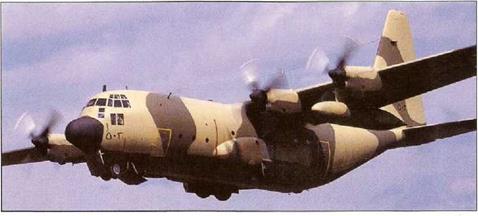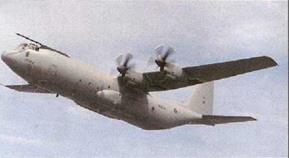Lockheed Martin C-13D Hercules

|
T |
he C-130 Hercules is the world’s most widely used and most versatile military transport, serving with 64 countries, The YC-130 first flew in August 1954. and was followed by the production C-130A in April 1955. An entire alphabet of specialised versions followed, but the basic transport aircraft had a straightforward evolution. In 1958 the C-130B introcuced more powerful T56-A-7A engines with four-bladed props and increased "uel tankage in the wings. In 1961 the C-130E arrivec, with yet more fuel and higher operating weights. The C-130H followed, initially as an export aircraft, but it became the definitive first-generation Hercu es variant, Powered by uprated T56-A-15 engines, the C-130H first flew in November 1964. The airframe featured a strengthened wing box, improved brakes and new avionics, The first production aircraft went to the RNZAF in 1965, and the USAF received its first С-1 ЗОН in April 1975.
The RAF’s C-130K (Hercules C. Mk 1) – based on the C-130H – has British avionics and equipment. Thirty were ‘stretched’ by 4.5 m (15 ft) to become C. Mk 3s, increasing capacity from 92 to 128 troops. With the addition of refuelling probes these aircraft became C. Mk iP/C. Mk 3Ps. Several nations are upgrading their older C-130s. Belgium
The most obvious difference between the C-130J and earlier models is the new aircraft’s AE2100 engines and their six-biaded ail-composite propellers.
This Royal Air Force of Oman С – 130H is typical of the many Hercules aircraft in every-day service all around the world today.
has fitted a ‘glass’ cockpit and new weather radar to its C-130Hs and Marshall’s of Cambridge have oeen doing similar work to South Africa’s C-13QBs. Many other operators have fitted missile warning equipment, chaff/flare dispensers and cockpit armour to their aircraft. Production of 2,156 first-generation C-130s ended rn 1998 with the delivery of з C-130H то Japan. By this time Lockheed (now Lockheed Martin) had developed its successor, the C-130J The C-130J began as a Lockheed private venture in 1991, as The ’Hercules ІГ. It modernised the С-1 ЗОН with new-technology engines and s:x-bladed proas, an advanced digital cockpit for two crew with HUDs as primary flight controls, a cigital engine management and diagnostic system. In 1994 the RAF became the launch customer, ordering 10 stretched C-130J-30S (Hercules C. Mk 4! and 15 C-130JS (Hercules C. Mk 5). Other customers include Australia, Italy, Denmark and the USA (including EC-130J, KC-130J and WC-130J variants), The first C-130J flew on 5 April 1996 but several unexpected problems slowed the flight test programme considerably. The first aircraft was not de ivered to the UK until August 1998 and further decays prevented the C-130J from entering service with the RAF until November 2000.

|










